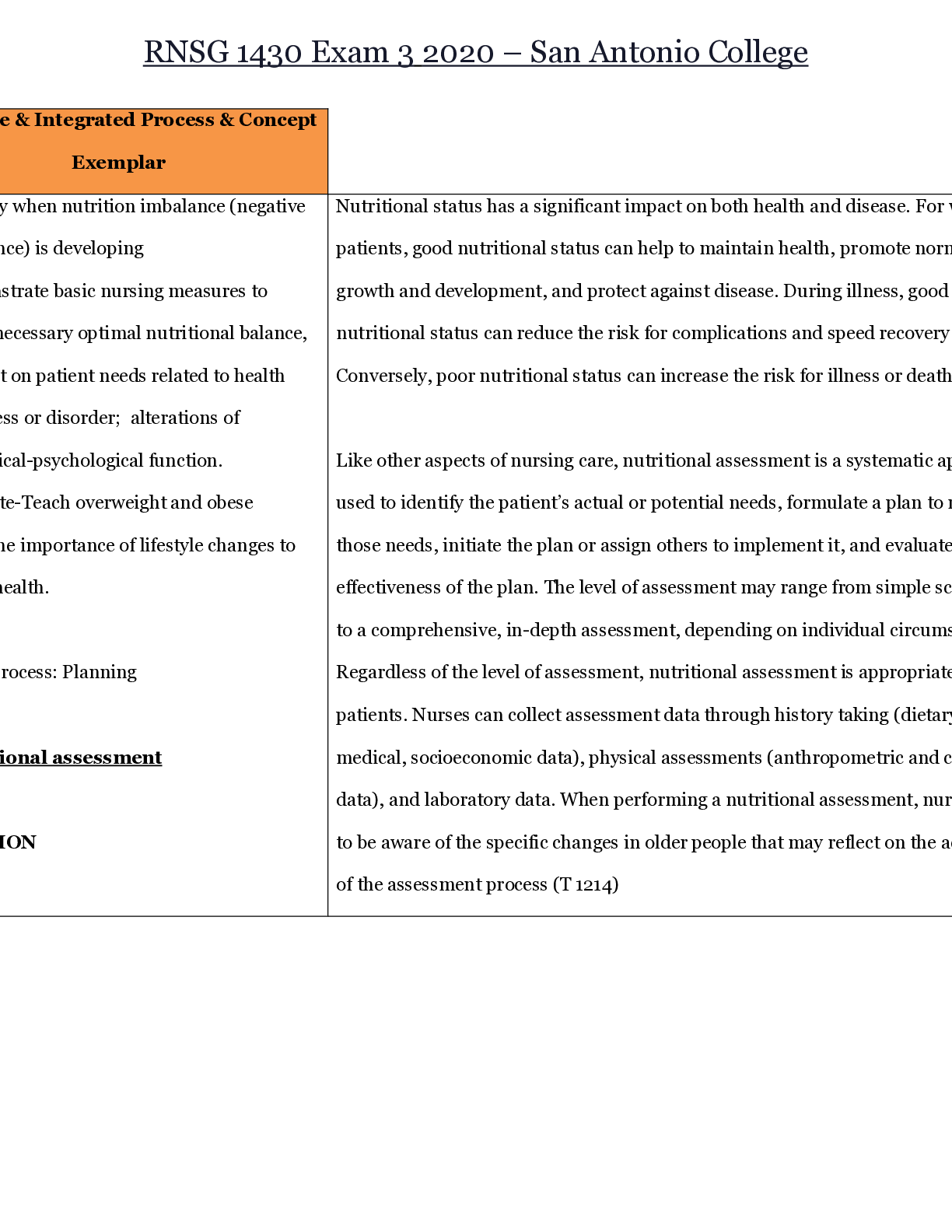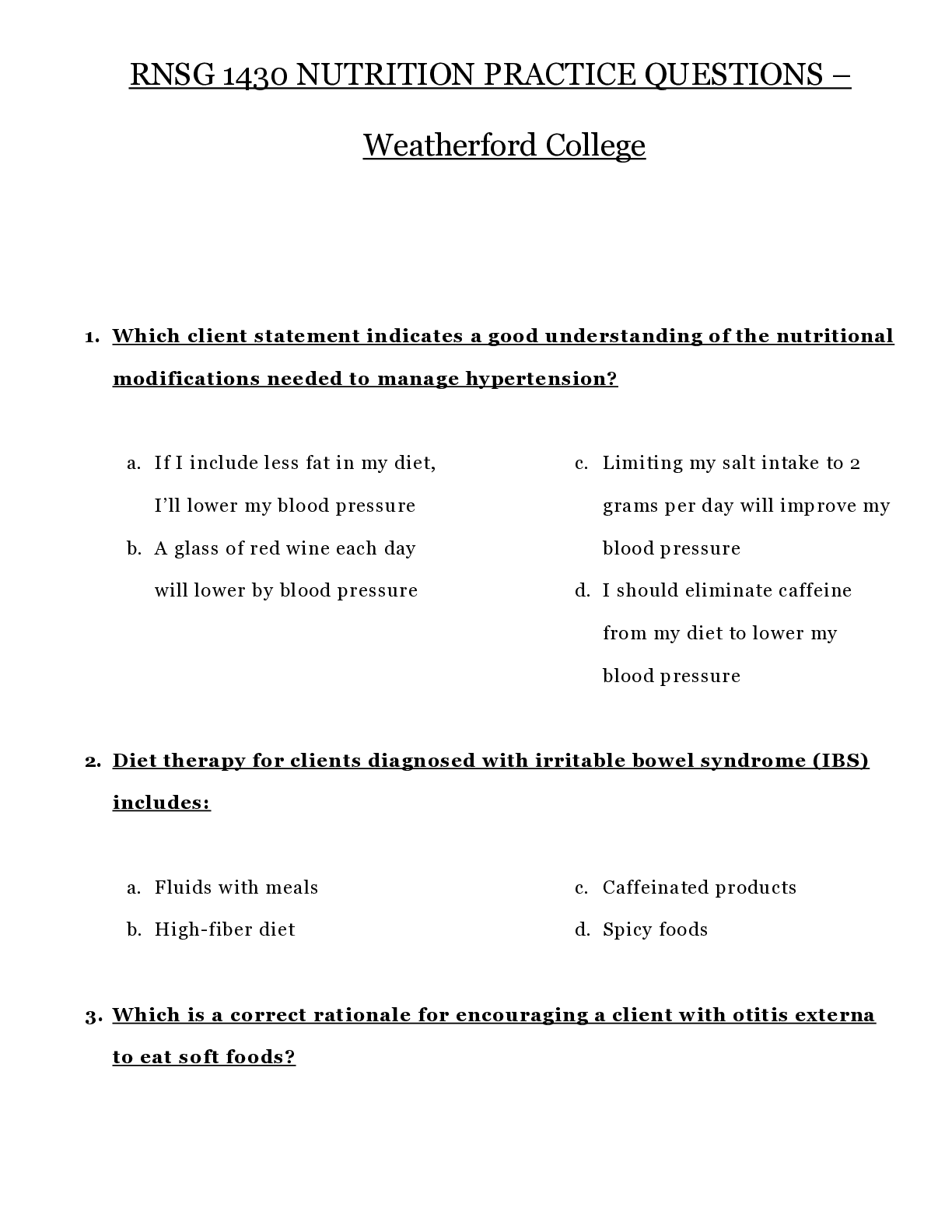*NURSING > EXAM > RNSG 1430 Raising the Bar for Success _ Tissue Integrity _ First Semester 2020 – El Centro College (All)
RNSG 1430 Raising the Bar for Success _ Tissue Integrity _ First Semester 2020 – El Centro College | RNSG1430 Raising the Bar for Success _ Tissue Integrity _ First Semester 2020
Document Content and Description Below
RNSG 1430 Raising the Bar for Success _ Tissue Integrity _ First Semester 2020 – El Centro College Raising the Bar for Success First Semester Tissue Integrity Know how to assess for tissu... e integrity? - - - - - -- What is the definition of tissue integrity? The ability of body tissues to regenerate and/or repair to maintain normal physiological processes. Integument – Structurally, Intact and Functioning, Normal Healing Process Who is most at risk for skin breakdown? Immobile, incontinent, diabetic, smokers, obesity, Protein Energy Malnutrition, Steroid intake and NSAIDS, Cancer patients that do chemotherapy and radiation therapy, Increased Alcohol intake. Decreased mental status Diminished sensation Excessive body heat Advanced Age Chronic Medical Conditions -- - - - - - - - - - - - - - What is the most common issue that affects skin integrity? Pressure at bony prominences? How do you assess tissue integrity when heat is applied to the skin? Do not use heat treatment more than 20–30 minutes Assess the skin sensation and integrity around the area to be treated. Heat treatment cannot be used over areas of blisters, burns, or redness indicative of burning Heat is one of the oldest nursing measures used to reduce pain and promote healing. Heat causes vasodilation and increases blood flow to the affected area, producing skin redness and warmth. Heat produces maximum vasodilation in 20 to 30 minutes; after this period, reflex vasoconstriction occurs along with tissue congestion. Periodic removal and reapplication of heat will restore vasodilation. Prolonged exposure to heat damages epithelial cells and results in redness, tenderness, and even blister formation. 1. The patient will derive the benefits of the heat treatment such as increased circulation and healing; decreased swelling, inflammation, pain, or muscle spasms; or thermoregulation. 1. If heat treatment is being used to decrease muscle tension or alleviate pain, then the client will experience a decrease in pain and tension. 2. If heat treatment is being used to increase circulation, then circulation will improve as demonstrated by color or assessment for blanching. 3. If heat treatment is being used to decrease edema, then the client will experience a decrease in swelling in the area being treated. - - - - - - - - - - - - - -- - Kinds of Wound Drainage Chemical mediators released during the inflammatory response cause vascular changes and exudation of fluid and cells from blood vessels into tissues. Exudates may vary in composition but all have similar functions. These functions include: 1. Dilution of toxins produced by bacteria and dying cells 2. Transport of leukocytes and plasma proteins, including antibodies, to the site 3. Transport of bacterial toxins, dead cells, debris, and other products of inflammation away from the site The nature and amount of exudate vary depending on the tissue involved, the intensity and duration of the inflammation, and the presence of microorganisms. Serous exudate is composed primarily of serum (the clear portion of blood), is watery in appearance, and has a low protein count. This type of exudate is seen with mild inflammation resulting in minimal capillary permeability changes and minimal protein molecule escape (e.g., seen in blister formation after a burn). Purulent exudate is also called pus. It generally occurs with severe inflammation accompanied by infection. Purulent exudate is thicker than serous exudate because of the presence of leukocytes (particularly neutrophils), liquefied dead tissue debris, and dead and living bacteria. The process of pus formation is called suppuration, and bacteria that produce pus are referred to as pyogenic bacteria. Purulent exudates may vary in color (e.g., yellow, green, brown) depending on the causative organism. Hemorrhagic exudate has a large component of red blood cells (RBCs) due to capillary damage, which allows RBCs to escape. This type of exudate is usually present with severe inflammation. The color of the exudates (bright red versus dark red) reflects whether the bleeding is fresh or old. Mixed types of exudates may also be seen, depending on the type of wound. For example, a serosanguineous exudate is clear with some blood tinge and is seen with surgical incisions. Red wounds are the color of normal granulation tissue and are in the proliferative phase of wound repair. These wounds need to be protected and kept moist and clean. Yellow wounds have either fibrinous slough or purulent exudate from bacteria. These wounds need to be cleansed of the purulent exudate, and nonviable slough needs to be removed. Black wounds contain necrotic tissue (eschar). Eschar may be either black, gray, brown, or tan. These wounds need debridement, which is the removal of nonviable necrotic tissue. Mixed color wounds often occur. The rule for treatment is to treat the worst color first. For example, a red and black wound would be debrided first. Then moisture and protection would be provided for the red portion. How does a wound vac help with wound healing? During the treatment, a device decreases air pressure on the wound. This can help the wound heal more quickly. It is negative pressure. Not a suction machine. It can gently pull fluid from the wound over time. This can reduce swelling, and may help clean the wound and remove bacteria. A wound VAC also helps pull the edges of the wound together. And it may stimulate the growth of new tissue that helps the wound close. A wound vacuum system has several parts. A foam or gauze dressing is put directly on the wound. An adhesive film covers and seals the dressing and wound. A drainage tube leads from under the adhesive film and connects to a portable vacuum pump. This pump removes air pressure over the wound. It may does this either constantly. Or it may do it in cycles. The dressing is changed every 24 to 72 hours How do you clean a wound when performing wound care? Wash hands, clean from inside out in circular formation - - - - - - - - - - - - -- - - - - - - How do you prevent skin break down for an immobile patient? Assessing skin break down… check to see if patient it incontinent and see if there is any moisture. Keeping skin dry and clean. Re-position pt every two hours to prevent skin breakdown. Clean sheets and wrinkle free sheets prevent shearing. Avoid clothes that have thick seams, buttons, or zippers that press on your skin DO NOT wear clothes that are too tight Keep your clothes from bunching up or wrinkling in areas where there is any pressure on your body When you are lying on your side, put a pillow or foam between your knees and ankles Never drag yourself to change your position or get in or out of bed. Dragging causes skin breakdown. moves you, they should lift you or use a draw sheet (a special sheet used for this purpose) to move you What must be done before wound care is performed? How does diabetes affect wound healing? High blood glucose causes stiffening of the arteries, narrowing of blood vessels, and diabetic neuropathy, which is nerve damage throughout the body, particularly the limbs. The effect of these body changes causes increased risk of wounds as well as more complications in diabetes wound healing hyperglycemia caused by decreased insulin availability and increased resistance to insulin can affect the cellular response to tissue injury diabetes with poorly-controlled blood sugars results in cellular dysfunction that impedes all phases of wound healing. - - - - - - - - - - - - - - - - - - - - - - ood carries to the wound are crucial to the healing process. By improving circulation and blood flow, more healing nutrients and oxygen reach the cells. Stage 1: Hemostasis Hemostasis happens immediately after an injury to skin causes bleeding. Your blood vessels constrict and reduce the flow of the blood to the injury site. Blood clots form within the injured blood vessels to prevent further blood loss. Stage 2: Inflammation Once a blood clot has closed the wound, the surrounding blood vessels are able to open up to deliver fresh nutrients and oxygen into the wound for healing. This process triggers macrophage, a white blood cell, to enter the wound, fight infection, oversee the repair process and send messengers, called growth factors, needed to heal the wound. Macrophage is the clear fluid you may see in or around the wound. Stage 3: Proliferation Proliferation is the growth and rebuilding phase, where blood cells arrive to help build new tissue to replace the tissue and cellular elements that were damaged during the process of wounding the skin. At this point, your body’s cells will produce a protein called collagen, which acts like scaffolding, to support the repair process. Stage 4: Remodeling The last wound healing stage is remodeling whereby the inflammation is gradually resolved and the collagen is deposited. New tissue takes the form of the original tissue and fills the area of the wound. We call this scar tissue, and while the wound may appear to have healed, it does not have the same strength as the normal tissue had before. It may take several months to a year for the healed wound to gain full strength. What lab work is important to know if your patient has a wound? Albumin is a protein that acts as a building block for cells and tissues. Because it is produced by the liver, albumin levels may be reduced in patients with liver disease. The albumin level is also diminished in patients with renal disease, malnutrition, severe burn wounds, and malabsorption syndromes. Adequate intake of protein and essential nutrients is necessary to ensure adequate production of albumin. Prealbumin, or transthyretin, is another type of protein produced by the liver. It has a half-life of 2 to 3 days, making it a better indicator of acute nutritional status changes than albumin. The level can be diminished in patients with liver disease, widespread tissue damage, malnutrition, protein wasting, or inflammation, as well as in patients taking estrogen or a hormonal contraceptive. Prealbumin carries thyroxine and vitamin A throughout the body; thus, lower prealbumin levels decrease transport of these substances. Hemoglobin A1c- An elevated A1c level carries the same implications as an elevated serum glucose level, including impaired wound healing and decreased ability to fight infection. A chronically elevated glucose level causes microvascular damage, which inhibits oxygen and nutrient perfusion and hampers wound healing. An elevated glucose level also affects polymorphonuclear lymphocytes, causing decreased chemotaxis, diapedesis, and phagocytosis, which in turn leads to a diminished ability to fight infection. Finally, an elevated glucose level is a risk factor for the development of arterial and neuropathic ulcers in patients with diabetes mellitus. A complete blood count (CBC) measures the number of red blood cells, white blood cells, total amount of hemoglobin in the blood, the fraction of the blood composed of red blood cells (hematocrit), and the mean corpuscular volume. The primary cell responsible for hemostasis is the platelet, which causes the body to form a clot to prevent further bleeding. Platelets also release key cytokines, such as platelet-derived growth factor, which recruit cells to participate in later phases of healing. Without the proper platelet count, wound healing is delayed. Name pharmacologic and non-pharmacologic ways to manage pain during wound care. Non-pharmacologic means that can assist in addressing pain including music therapy, relaxation strategies, meditation, imagery, physical activities, rest, repositioning and physical modalities such as Transcutaneous Electrical Nerve Stimulation (TENS) Step 1: A non-opiod analgesic (NSAID) with or without an analgesic adjuvant. Adjuvants include tricyclic antidepressants, anticonvulsants, antihistamines, benzodiazepines, steroids, and phenothiazines. Adjuvants are given for their indirect benefits in pain management.1,20 Step 2: If pain is not controlled: Continue the initial medication and add an opioid, such as codeine or tramedol, and an adjuvant.1,20 Step 3: When a patient does not respond to second-step medications, these should be discontinued and a more potent oral narcotic initiated. - - - - - - - - - - - - - - - - - - - - - - - o A Wood’s light is also known as a black light and is a handheld device that can identify certain fungal infections that fluoresce under long-wave ultraviolet light. In a darkened room, when a physician or nurse aims the light at a lesion caused by a fungus that fluoresces, the lesion emits a blue-green color. It is the only test that uses a light, the others use skin scrapings o A papule is a small, circumscribed, solid elevation of the skin. o Cryosurgery: Through the application of extreme cold, the tissue is destroyed. o Blanching of the skin occurs when the skin becomes white or pale in appearance. Blanching of the skin typically indicates a temporary obstruction of blood flow. If you press gently on an area of your skin, it likely turns lighter before resuming its natural color. [Show More]
Last updated: 1 year ago
Preview 1 out of 19 pages
Instant download
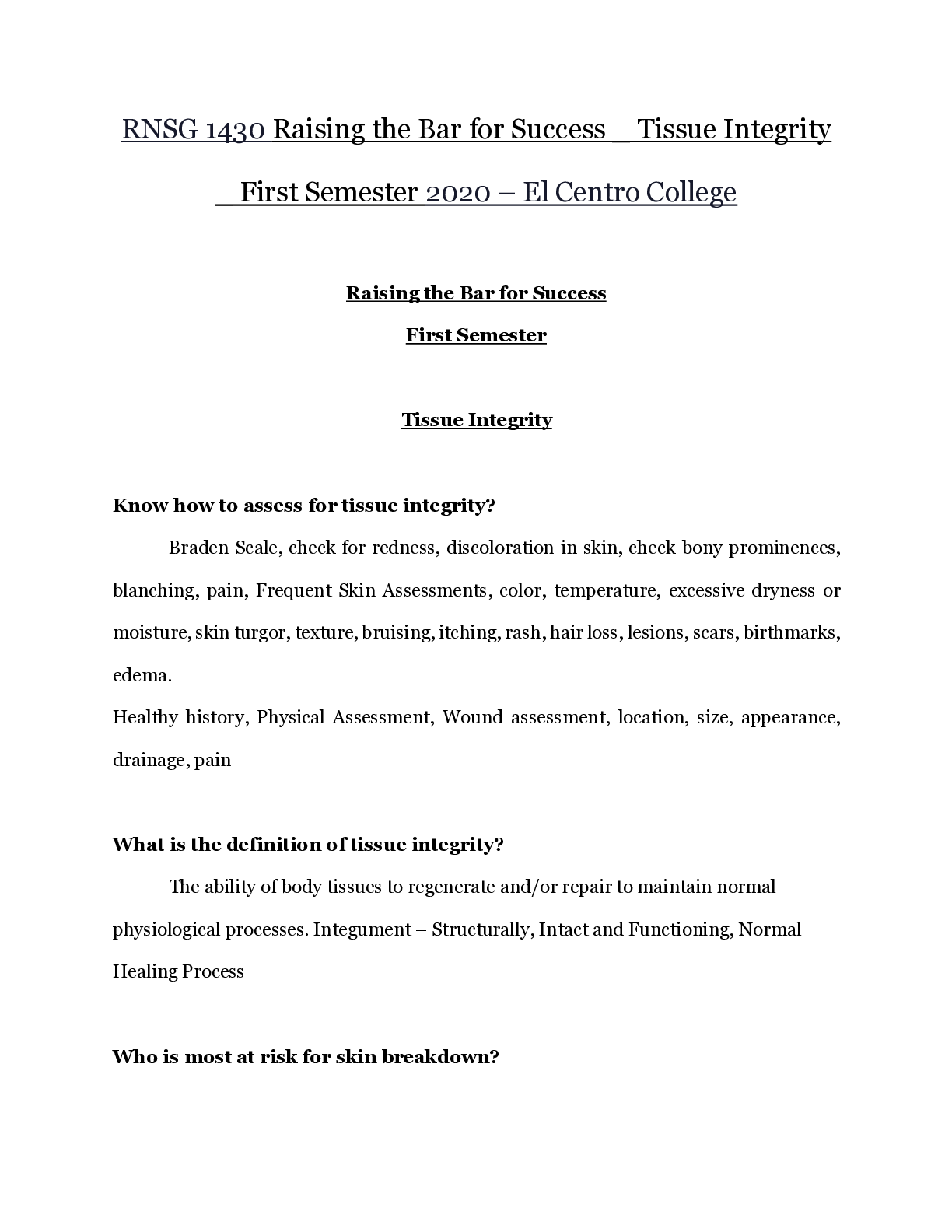
Buy this document to get the full access instantly
Instant Download Access after purchase
Add to cartInstant download
Reviews( 0 )
Document information
Connected school, study & course
About the document
Uploaded On
Nov 01, 2020
Number of pages
19
Written in
Additional information
This document has been written for:
Uploaded
Nov 01, 2020
Downloads
0
Views
34













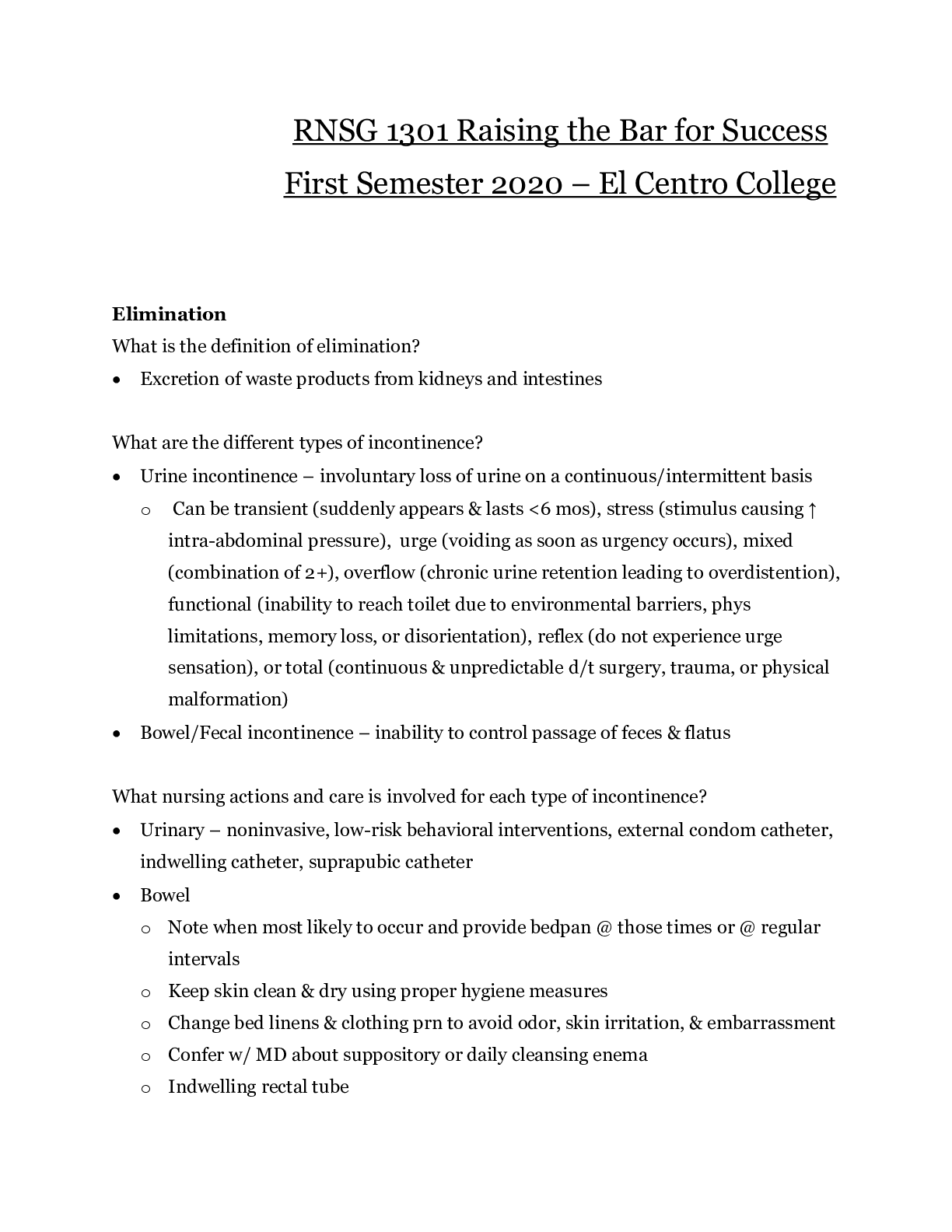
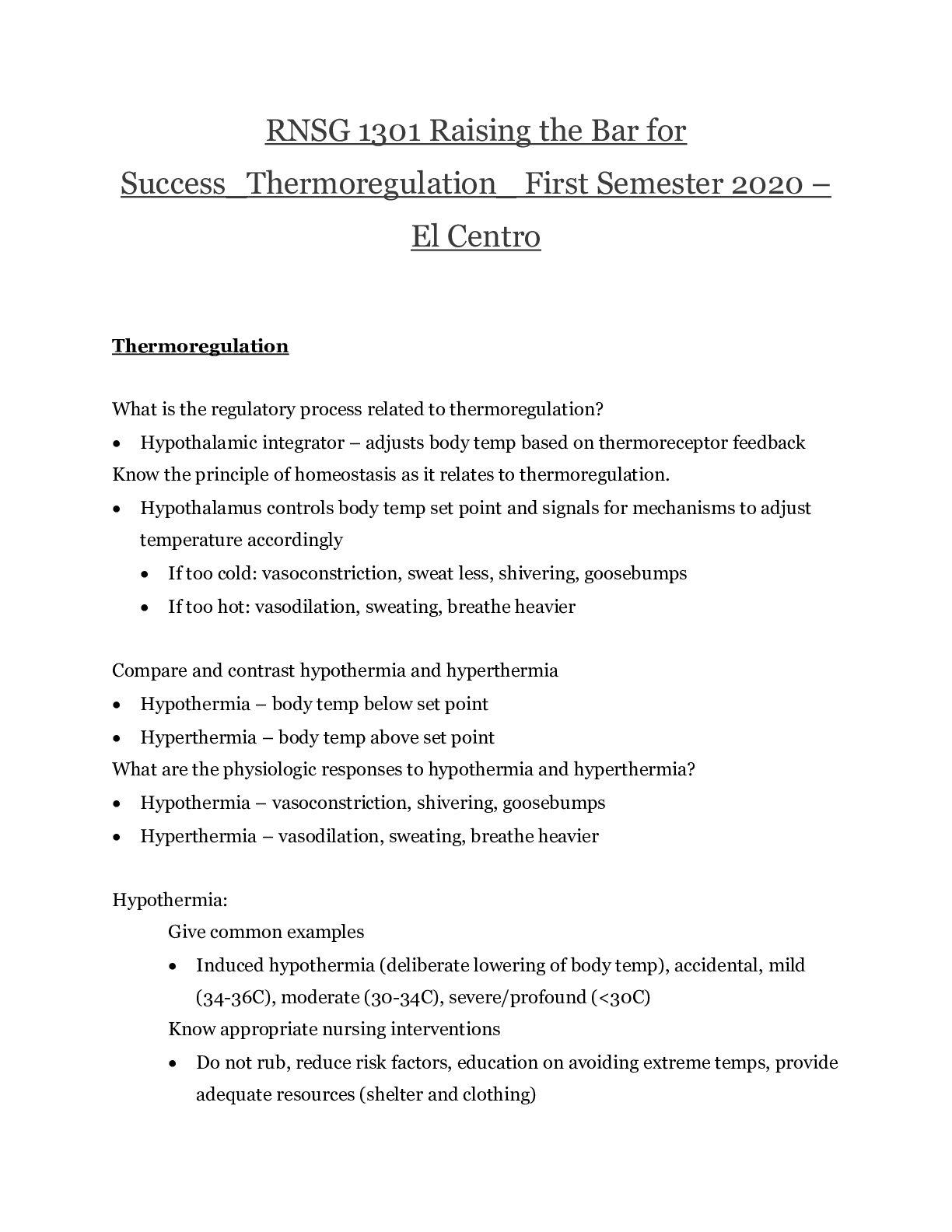
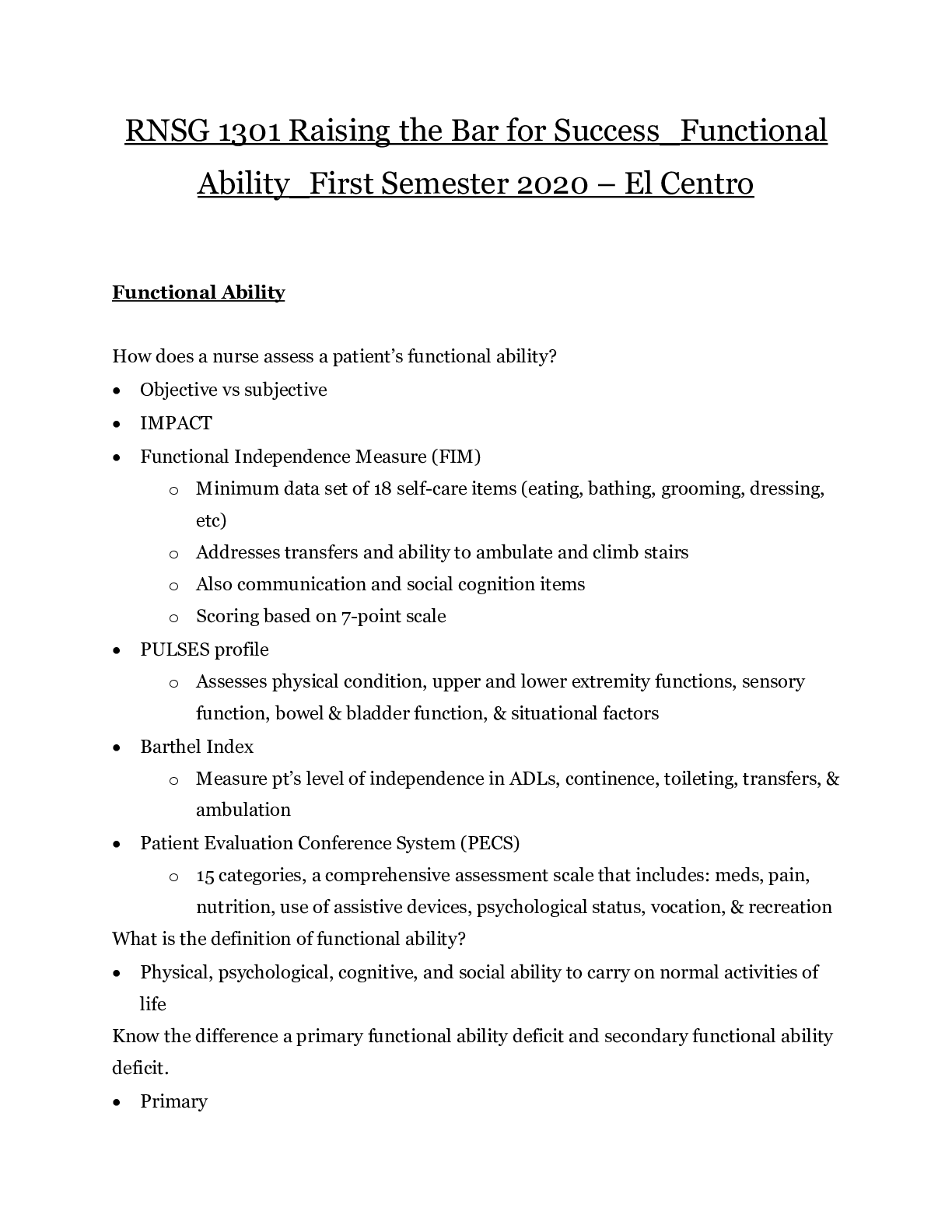

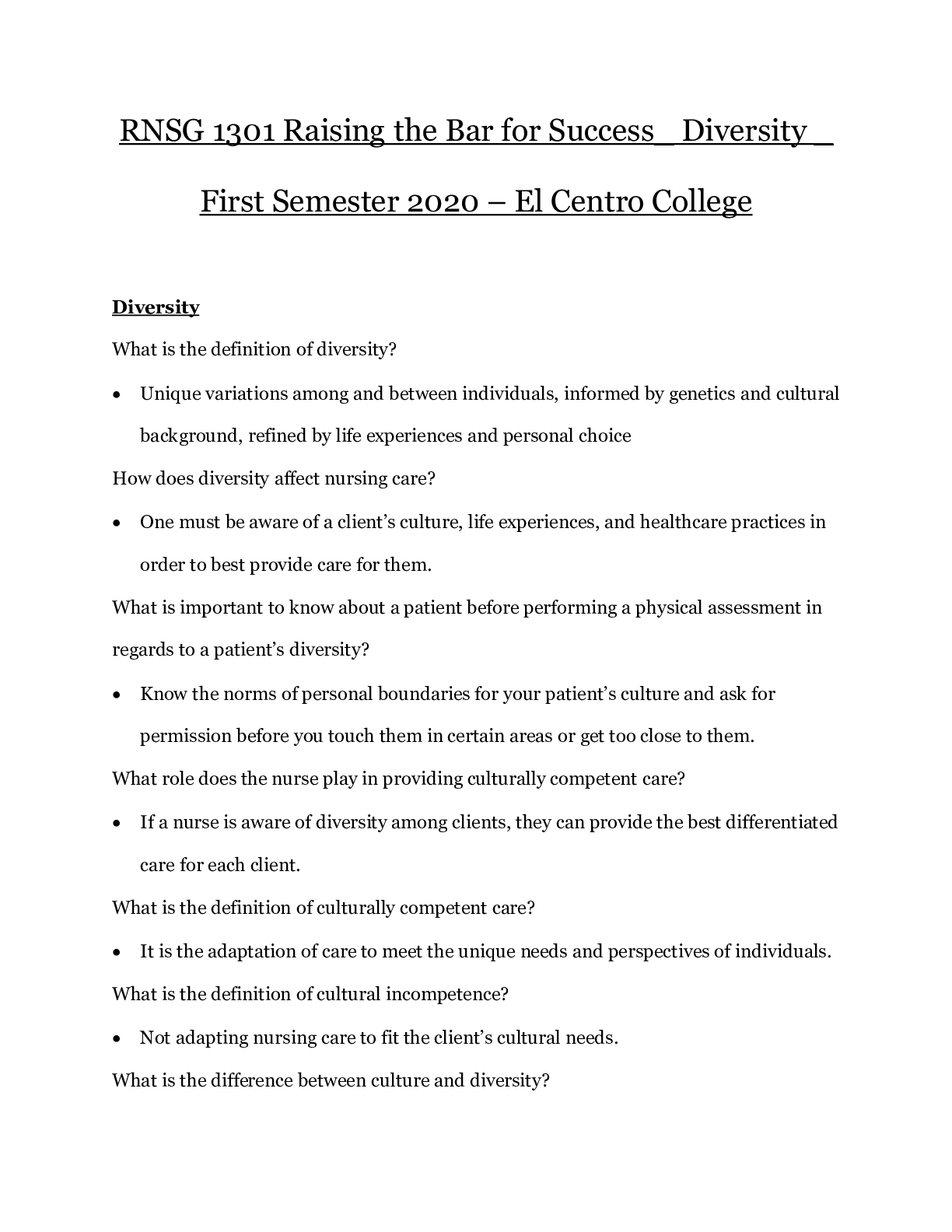
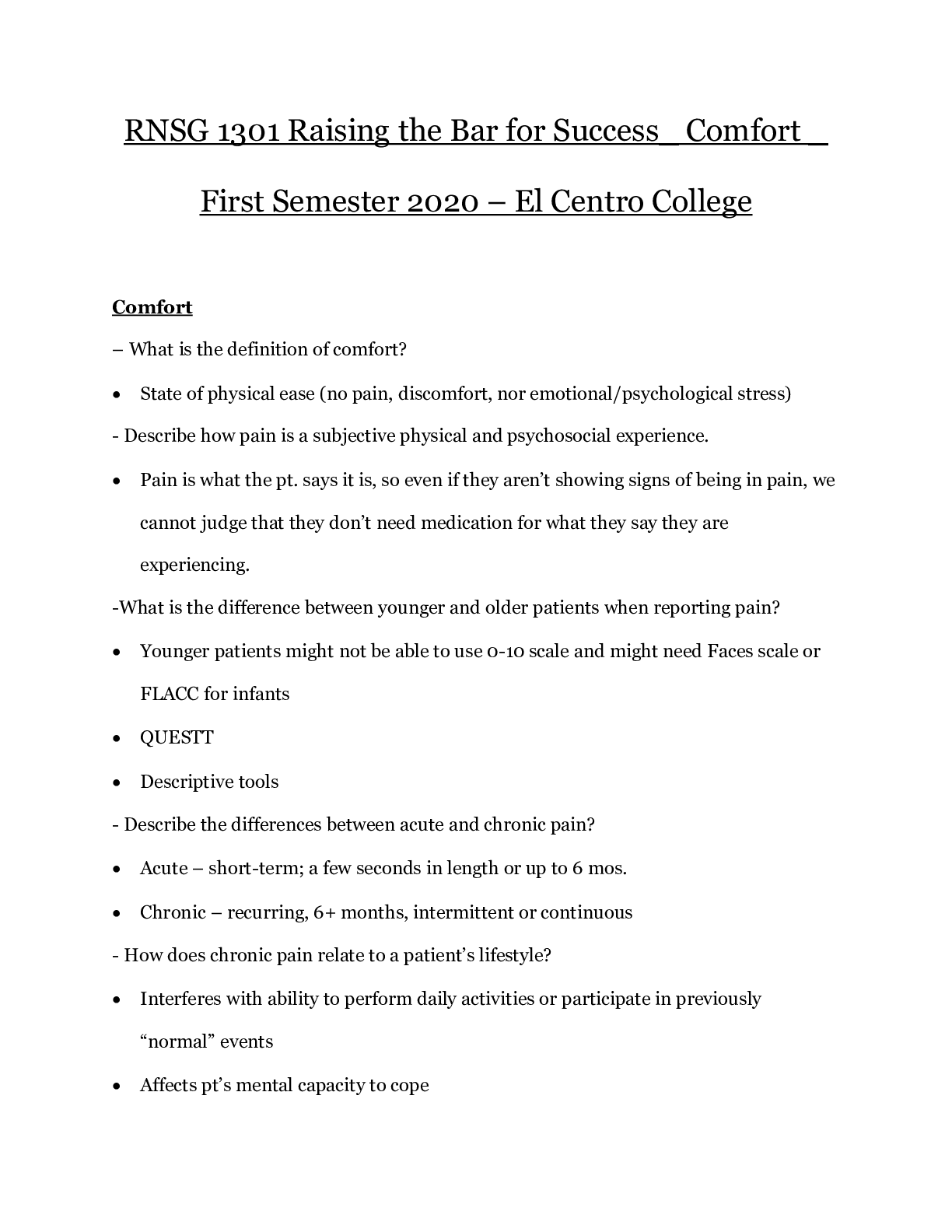
 – El Centro College.png)
 – El Centro College.png)
